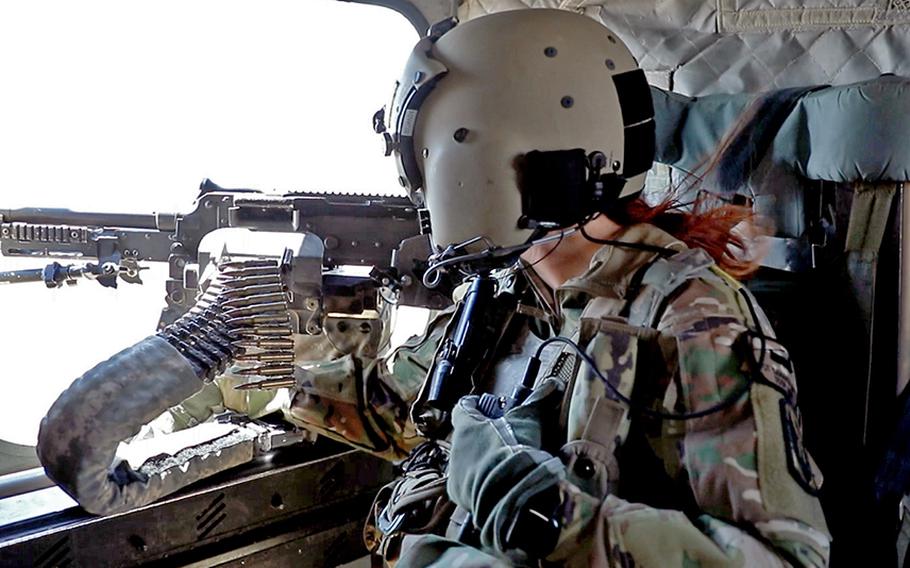
Sgt. Samantha Harvey, a CH-47 Chinook helicopter crew member with the 3rd General Support Aviation Battalion, 126th Aviation Regiment of the Massachusetts Army National Guard, scans outside the helicopter while conducting operations near al Asad Air Base, Iraq, on Aug. 23, 2023. (Shane Hamann/U.S. Army National Guard)
WASHINGTON — The number of attacks against U.S. bases in Iraq and Syria and the number of injuries to American troops keeps rising, the Pentagon said Monday.
Close to 50 U.S. service members at several bases in the two countries have been injured by drone or rocket attacks fired by militant groups aligned with Iran between Oct. 17 and Oct. 26, Pentagon officials said. At al-Tanf garrison in southern Syria, 32 troops have been injured and another 13 troops have been hurt at al Asad Air Base in western Iraq. There also has been at least one injury at a base in Erbil in northern Iraq.
“All of these injuries occurred prior to the self-defense strikes we took [in Syria] on Oct. 26,” said Air Force Brig. Gen. Pat Ryder, the Pentagon’s top spokesman. “To my knowledge, there have been no injuries reported since then.”
Of the known injuries, about half were traumatic brain injuries, which can vary in severity. Ryder said two American service members with head injuries briefly returned to duty before they were sent to a medical base in Germany for further evaluation. They are in stable condition, he said.
The updated casualty figure is higher than the 21 troops that the Pentagon announced last week. Ryder said the figures often fluctuate because sometimes injuries aren’t immediately apparent.
“This can happen for a number of reasons, [such as] individuals initially dismissing the severity of the injuries they sustained … or symptoms presenting themselves after initial reporting,” he said. “It’s not unusual for service members to come in after the fact, days later.”
There’s also been a rise in the number of attacks on the bases. Pentagon officials said Monday that there have been 38 separate strikes in the last three weeks — up eight since Friday — and five of them had occurred in the past 24 hours.
“Since Oct. 17, we have had 20 attacks in Iraq, 18 in Syria,” Ryder said, describing them as “harassing attacks” involving drones and rockets.
The Pentagon previously said the groups behind the attacks are essentially Iranian proxy groups, sponsored, funded and trained by Tehran, but the Defense Department has been reluctant to connect the rise in attacks to the fighting between Israel and Hamas militants, who are also backed by Iran.
Recently, the U.S. military deployed an additional 1,200 troops to the Middle East to support Israel and protect other troops in the region. But the Pentagon has said their primary objective is to deter others from escalating the Israel-Hamas fight. The American service members in Iraq and Syria are part of the U.S. forces in the region deployed to support the ongoing campaign against the Islamic State group.
“A major focus for the Department of Defense is to deter a broader regional conflict, and so you’re seeing … groups that may try to exploit the situation to benefit their own interests, to include Iranian proxy groups,” Ryder said. “We have known for a long time that one of Iran’s broader strategic goals is forcing the United States out of the region, and they have employed these proxy groups.”
In addition to the recently deployed troops, the Pentagon has mobilized a host of other U.S. military power to the region since Hamas attacked Israel on Oct. 7, including fighter jets and two Navy aircraft carrier strike groups. The department said Sunday that an Ohio-class, nuclear-powered submarine had arrived in the region. The Pentagon also said last week that it’s flying drones over Gaza — the Hamas-controlled territory southwest of Israel — searching for the roughly 200 hostages taken by the militant group. So far, only a few hostages have been released.
Hamas killed more than 1,400 people in the Oct. 7 attack. Since then, retaliatory Israeli airstrikes have killed scores of Palestinian civilians in Gaza.
“We know the numbers are in the thousands. [We] don’t have a specific number,” Ryder said of the Palestinian deaths. “This is a reason why it has been a point of emphasis in our discussions with the Israelis on how important it is to get humanitarian assistance and aid into Gaza.”